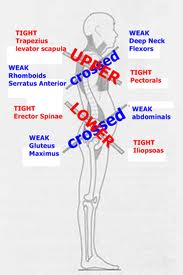Seeing as one of my goals (as written in the previous post) is…
Promote superior resistance to wear and tear and common injuries.
– Janda’s upper crossed/lower crossed/layer syndrome
…I want to write a little intro to Janda and his work. Hopefully to the benefit of those of you who read my log.
Vladimir Janda, a Czechoslovakian neurologist and exercise physiologist categorized muscles as being either tonic/postural or phasic.
A short overview of the most important muscles in each category:
Tonic/postural muscles (prone to tightness or shortness)
Sub occipitals. (small muscles in your upper neck, below the skull)
SCM
Trap 1
Levator scap
Pec major/minor
Biceps
Hip flexors (psoas, iliacus, rectus femoris, satorius, tensor etc.)
Lower back extensors
adductors
Piriformis
Hamstrings
Calf Muscles
Phasic muscles(prone to weakness or inhibition)
Neck flexors (Longus coli and capitis)
Serratus anterior
Mid-back (Rhomboids, lower traps)
Deltoid
Triceps
Glutes (max, med, min)
Abdominal muscles
Quad (minus rectus femoris, which is a tonic hip flexor)
These dysfunctional patterns of tightness/weakness manifest what Janda called…
– upper crossed syndrome (cervical hyperlordosis, thoracic hyperkyphosis) and
– lower crossed syndrome (anterior tilt of the pelvis/hyperlordosis of the lower back)
…(and what the rest of us might just call poor posture) due to the ‘crossing’ junctures resulting from the tonic and phasic muscles at these locations:
Upper and Lower crossed together:

Addressing the tonic/phasic pattern is really good stuff for unwinding foundation issues of many of the problems we have in our musculo-skeletal system.
As you can see from the list, it fits very well with all the pre/rehab advice you get in a clinic or around the web for what ails you in different parts of your body: Do glute activation, stretch hip flexors, stretch the pecs, do pushups for the serratus, work on extension of the thoracic spine, stretch the piriformis, do more one-legged work to get hip-stability (glut. med.) etc. etc.
By adressing the muscles in these categories (activate the phasic muscles, stretch/mobilize the tonic ones) you will prevent, cure or at least influence virtually ALL musculo-skeletal problems and pains in a postive way, since you are dealing with optimization of fundamental muscular patterns in the body.
A ‘perfect’ routine should address this and at least the muscles involved in upper and lower crossed syndrome. It is something I aspire to do in my own minimalist program. How it does that is probably something I’ll elaborate on in another post later.

